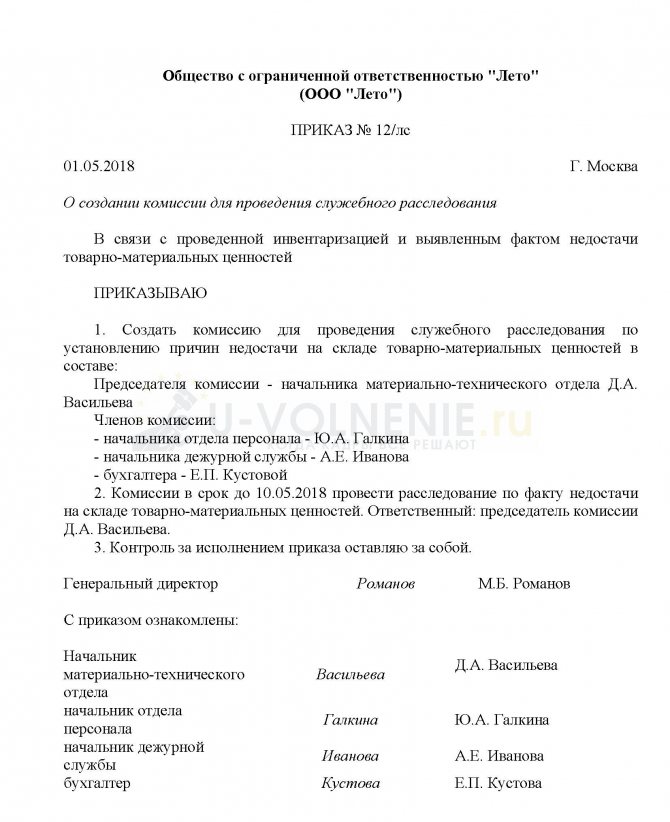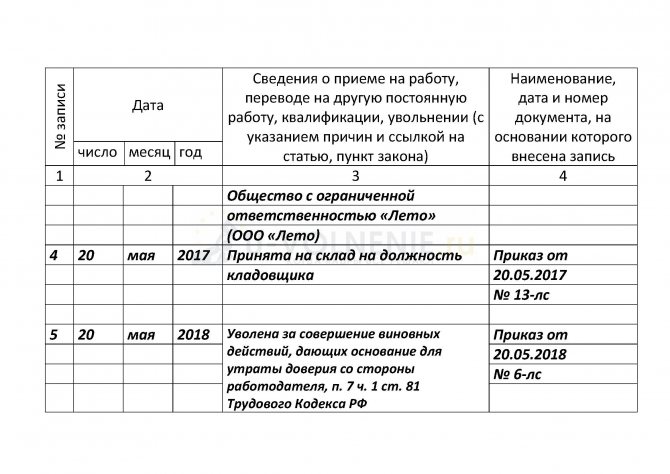Free legal consultation by phone:
8
Such a sensitive basis for dismissal is rarely used in practice. Firstly, the human factor plays a big role - it will be quite difficult for a careless worker to find a good job in the future. Therefore, the contract is often formally terminated at the request of the employee or by agreement of the parties. Secondly, the procedure for terminating the contract itself differs in certain features. Very often, the employer’s ignorance of the slightest nuances leads not only to nerves and waste of money, but also to lengthy litigation in court.
What is loss of trust
What is meant by loss of trust?
What a loss of trust is is not set out in labor legislation, but there is an explanation of what an employer should do if an employee has violated contractual obligations in relation to financial and material assets.
Job loss is associated with the following illegal actions:
- causing damage;
- committing theft;
- destruction of property;
- failure to comply with regulations regarding material assets;
- failure to comply with the rules for conducting cash transactions;
- sale of goods at inflated or reduced prices;
- illegal drawing up of property write-off acts;
- fraud in relation to the employer's property.
If the employer notices that his employee has committed illegal actions, then the former has the right to dismiss the latter under the article.
The labor legislation does not have a specific article on the dismissal of employees due to loss of trust. The employer also has the right, based on its own decision, taking into account a number of factors, to conduct investigations to identify arguments.
The reasons for the loss of trust may be actions related to the circulation of material assets, including their theft, unreasonable waste, but again this must be thoroughly proven before taking action, otherwise everything may turn against the employer.
Features of calculation and payments
Any civil or municipal employee receives a paycheck upon dismissal. The calculation itself may include:
- basic payments upon dismissal (salary, vacation pay);
- additional (various bonuses and allowances);
- the presence of a material penalty.
In fact, when calculating, from the funds paid upon dismissal, the amount for which the damage was caused may be deducted. In most cases, in case of serious violations, in particular of a corruption nature, those dismissed must also pay a state fine.
It is necessary to remember that the calculation must be made no later than the day of dismissal specified in the order, since failure to comply with such a rule is a violation on the part of the employer.
All payments and penalties must be entered on the payslip, which is issued along with the rest of the documentation.
Sample of filling out a pay slip - front side
Sample of filling out a pay slip - reverse side
Important! If the damage is greater than the payments upon dismissal, then the recovery is formalized through the court, that is, the dismissed employee must subsequently pay off all damage caused within the period established by the court.
Read on the topic: Grounds for dismissal due to loss of confidence in the employee
Read on topic: Termination of powers of a deputy due to loss of confidence
Who gets fired due to loss of trust
The employer has the right to dismiss due to loss of confidence of employees of the following categories:
- Warehouse Manager;
- merchandiser;
- cash register worker;
- serviceman;
- civil servant.
If the employee is in the public service, then dismissal is made on the basis of a memorandum from the personnel service or on the basis of a prepared act.
Features of employee dismissal
Each type of employee has its own characteristics that must be taken into account when dismissing. Nuances of the civil service:
- a wide range of powers has additional restrictions that are not used for ordinary categories of employees;
- personal and state interests must be maintained in the form of a balance. If personal interests outweigh when performing official duties, then a basis for loss of trust is created;
- verification of the authenticity of the violation and dismissal is provided for by Presidential Decree No. 1065;
- as for other categories of citizens, a full verification procedure is also provided with the involvement of a special commission.
A municipal employee has more opportunities to lose trust. If the main offense for civil servants is violation of corruption rules, then a municipal employee has a number of grounds for dismissal procedures due to loss of trust. This includes both a conflict of interest and failure to perform official duties.
Dismissal of civil or municipal employees due to loss of confidence is possible only if all the evidence is available. The dismissal procedure includes several stages and takes into account all the employee’s labor rights. The entire process of collecting evidence and further actions are standard for all categories of employees.
Grounds for dismissal
Grounds for dismissal due to loss of confidence
Loss of Confidentiality - This ground applies to government employees. Only a representative of a government agency can terminate a contract with the explanatory wording “loss of trust” due to:
- violation of restrictions;
- failure to comply with requirements;
- ignoring the fulfillment of duties.
Firing a CEO is different from firing a low-level employee. This is usually due to the specifics of work activity, that is, the implementation of the responsibilities and rights of the owner. The General Director may be dismissed based on a decision of one of the members of the special meeting based on a disciplinary violation.
The dismissal of the chief accountant is possible due to a violation of his financial activities, since he is in charge of all material assets.
The dismissal of a civil servant occurs for the following reasons:
- When a conflict of interest arose, appropriate measures were not taken in a timely manner.
- All information about taxes, as well as information about these circumstances, is not provided.
- Illegal participation in a commercial project with the receipt of funds.
- Illegal business activities were carried out.
- Relations with employees of foreign organizations.
- Have an account abroad.
- Personal interest in conflict situations.
If an employee violates the law, he automatically falls under the article on loss of trust. The employer’s actions in relation to this employee are not just termination of contractual obligations, but an investigation followed by recourse to the courts.
Necessary activities
If there is a violation in the performance of his duties by an employee, the employer must first begin checking this fact. Further results of the audit will show whether there are grounds for dismissal.
Important! The verification procedure is mandatory and complete. Otherwise, its results will not be justified.
Step by step procedure:
- identification of a violation, that is, there must be a fact of misconduct;
- creation of a disinterested commission (the number can be any, but strictly not less than three persons);

Sample order to create a commission to conduct an internal investigation
- conducting an audit that reveals all aspects of the violation and the degree of guilt of the employee;
- based on the evidence received, which must be documented, the punishment procedure is carried out;
- disciplinary action in the form of dismissal requires a serious violation, as well as a complete loss of confidence in the employee;
- an order is issued on the basis of which the calculation and dismissal of the employee is made, as well as financial penalties, if necessary.

Sample entry in the work book about dismissal due to loss of trust
Important! An employee can be punished only if there is a complete evidence base, as well as legal grounds, since some employees do not have certain forms of responsibility.
All responsibility, which may serve as a further basis for dismissal due to loss of trust, is prescribed in a number of documents:
- employment contract and amendments to it;
- additional agreements on liability, including those of a property or material nature;
- job description, which specifies all responsibilities.
All persons who are civil or municipal are under constant control by various government bodies. It is worth considering that the grounds for dismissal of this category may be a government audit that will reveal violations and the violator.
An important point is the drawing up of an order, which must be presented to the perpetrator against signature. If the dismissed person refuses to sign the letter, then the order is read out in front of witnesses, in the presence of the guilty person.
The specified date of dismissal is considered the last working day during which payment must be made.
Dismissal process
Algorithm for the dismissal procedure
In order for an employer to fire an employee who has lost confidence, you can use the following algorithm of actions:
- Drawing up a report by the employee who noticed the violation. State the reasons for dismissal clearly and concisely.
- Formation of a commission based on the observed violation.
- Work of the commission. Members of the commission must establish the facts of what happened, thoroughly review the evidence, recalculate the availability of material assets and determine what is missing. Evidence of guilt must be found and presented to the accused.
- Preparation of a report based on the results of the work of the commission members. Record the document in the prescribed form.
- Familiarize the employee who committed the violation with the Act.
- Terminate the employment agreement unilaterally.
- Preparation of an administrative document for dismissal from the enterprise. Moreover, there is no need to demand any explanation from the employee.
Drafting a memorandum
Today there are no specially provided forms for drawing up documents, so everything is recorded in the report of the employee who noticed the misconduct of his colleague.
The report should also contain information:
- The full surname and initials of the employee on whose part the illegal actions were committed.
- Date and preferably time when the violation was noticed.
- During what work was the damage observed (for example, during an inventory).
- List of documents confirming the fact of violation.
Based on the above, an administrative document is prepared.
How to document a violation
There is no clear, legally regulated form of document to reflect the discovered fact of violations committed by an employee . As a rule, this is a memorandum in free form, including:
- identification data (full name, position) of the initiator of the document that discovered the violation;
- a description of the facts identified and the conditions under which they were committed;
- date and personal signature of the compiler.
If the violation took place outside the employer's territory, he will receive documents from investigative authorities or from the court. does not need to compose anything additional .
Making an order
Order of dismissal
After the fact of violation was noted, the organization had to prepare a draft administrative document.
It should reflect the following information:
- The preamble describes the offense that was committed and states the facts.
- The order part of the document clearly and concisely states what the employee violated and when it was noted. The composition of the commission to conduct an investigation into the incident is determined. The working hours of the commission and the time for preparing the act are determined.
- After preparation, the draft order undergoes legal examination and after receiving a positive conclusion, it is agreed upon with interested parties and signed by the head.
The employee who committed the violation must be familiarized with the Order. The commission can work independently and the decision made based on the work can be the final verdict. If controversial issues arise, you should contact the court.
The procedure for requesting explanations from the perpetrator
If the employee himself is ready to give written explanations on the current situation, he does not need to be given a written request to give them. It is enough to receive his voluntary explanations in paper form.
If a conflict arises and the employee clearly does not want to give explanations, he should be given a notification of their provision against signature. After this he has 2 working days to respond. If explanations are not received within the specified period, an act of refusal to provide explanations is drawn up.
List of documents for dismissal
To ensure the implementation of the procedure, it is worth knowing what documents should be in the package and how to behave with an employee who has violated the norms.
In order not to violate the rights of a subordinate, you must:
- Notify the employee about the discovery of the pass, and do this in writing.
- Issue an administrative document regarding what has been identified.
- Make a full settlement with the employee.
- Issue documents: pay book and salary certificate for the last year of work.
If the employer discovers that the employee has committed misconduct, the former has the right to terminate the employment agreement at any time. Issuing a warning about a violation is not standardized according to time indicators.
If the employee receives the notification, then he familiarizes himself with it and signs it, and if he refuses to sign it, then the employer draws up a free-form act.
How to conduct an investigation and document its results
To confirm the detected violations, a commission is created for an internal investigation. It should include who are not interested in the outcome of the proceedings. Its number is at least 3 people . To do this, issue an order in any form, which indicates:
- positions and names of persons involved in clarifying all the circumstances of the offense;
- powers of commission members;
- objectives of the investigation;
- its duration.
The commission must:
1. Identify all the conditions under which the violation was committed.
2. Establish a list of valuables that are lost or damaged.
3. Inspect the place where the violation occurred.
4. Assess the amount of direct actual damage.
5. Identify the guilty employees and obtain evidence of their guilt.
6. Establish the circumstances that contributed to the commission of the offense.
All members of the commission are introduced to the order against signature.
Based on the results of the actions taken, an act is drawn up. It provides the following information:
- a list of employee actions that give grounds for mistrust;
- conditions for committing unlawful acts;
- the amount of damage caused or possible damage caused by them;
- the degree of guilt of the employee and proposals for applying punishment to him.
The act is signed by all members of the commission, and the employee gets acquainted with it against signature. If he refuses to familiarize himself, this is also documented in a separate act.







